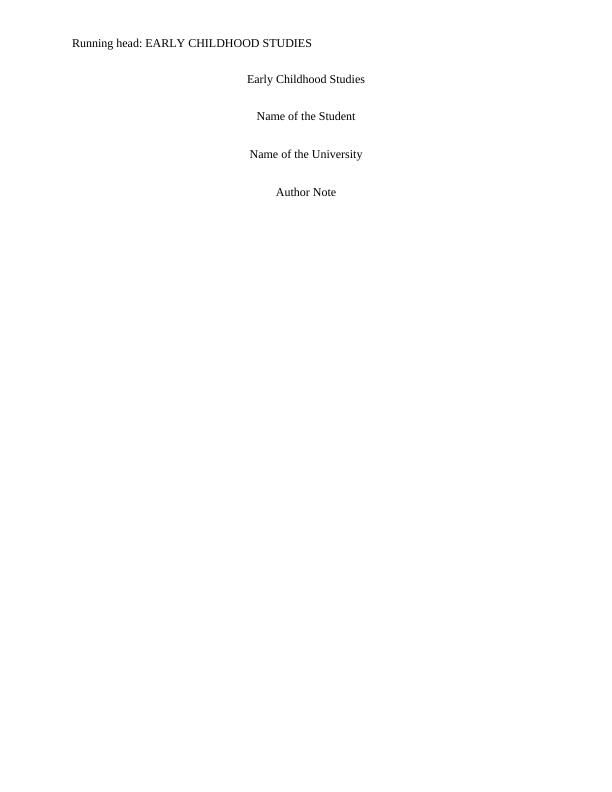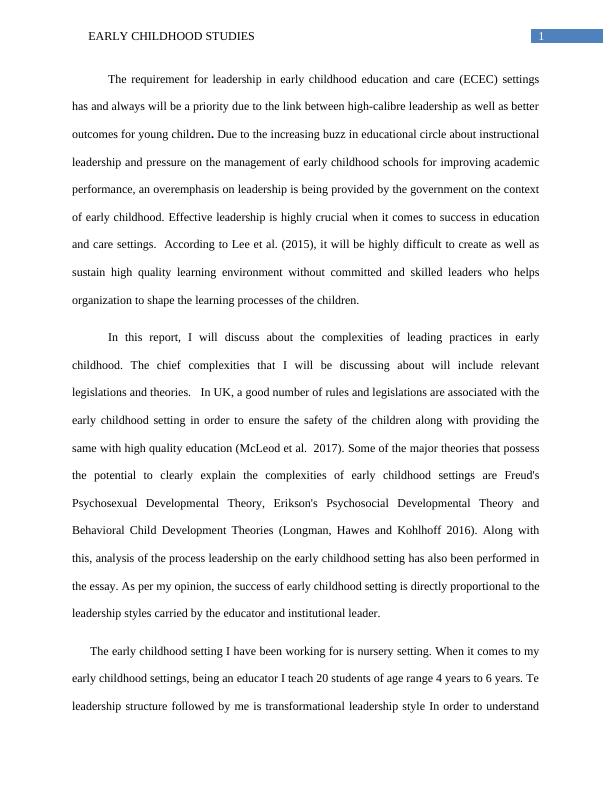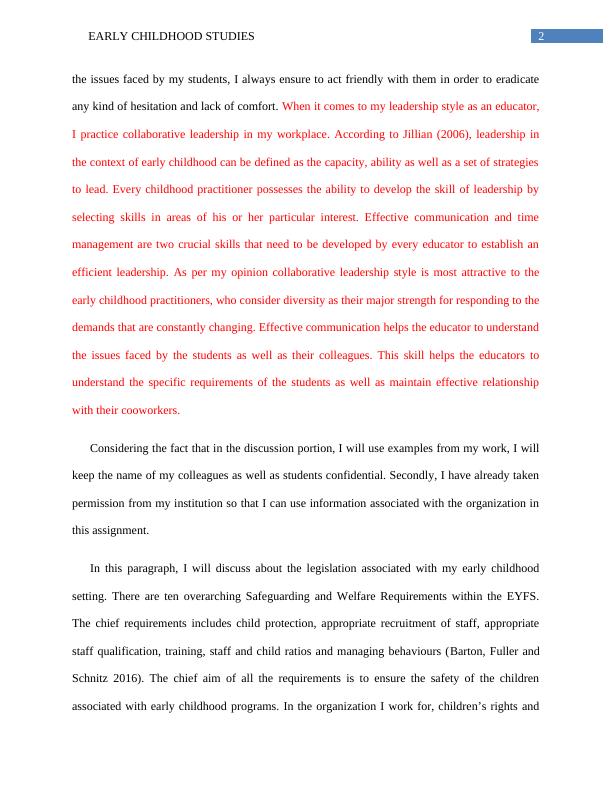Leadership in Early Childhood Education and Care Settings
Added on 2023-04-21
7 Pages1716 Words348 Views
Running head: EARLY CHILDHOOD STUDIES
Early Childhood Studies
Name of the Student
Name of the University
Author Note
Early Childhood Studies
Name of the Student
Name of the University
Author Note

1EARLY CHILDHOOD STUDIES
The requirement for leadership in early childhood education and care (ECEC) settings
has and always will be a priority due to the link between high-calibre leadership as well as better
outcomes for young children. Due to the increasing buzz in educational circle about instructional
leadership and pressure on the management of early childhood schools for improving academic
performance, an overemphasis on leadership is being provided by the government on the context
of early childhood. Effective leadership is highly crucial when it comes to success in education
and care settings. According to Lee et al. (2015), it will be highly difficult to create as well as
sustain high quality learning environment without committed and skilled leaders who helps
organization to shape the learning processes of the children.
In this report, I will discuss about the complexities of leading practices in early
childhood. The chief complexities that I will be discussing about will include relevant
legislations and theories. In UK, a good number of rules and legislations are associated with the
early childhood setting in order to ensure the safety of the children along with providing the
same with high quality education (McLeod et al. 2017). Some of the major theories that possess
the potential to clearly explain the complexities of early childhood settings are Freud's
Psychosexual Developmental Theory, Erikson's Psychosocial Developmental Theory and
Behavioral Child Development Theories (Longman, Hawes and Kohlhoff 2016). Along with
this, analysis of the process leadership on the early childhood setting has also been performed in
the essay. As per my opinion, the success of early childhood setting is directly proportional to the
leadership styles carried by the educator and institutional leader.
The early childhood setting I have been working for is nursery setting. When it comes to my
early childhood settings, being an educator I teach 20 students of age range 4 years to 6 years. Te
leadership structure followed by me is transformational leadership style In order to understand
The requirement for leadership in early childhood education and care (ECEC) settings
has and always will be a priority due to the link between high-calibre leadership as well as better
outcomes for young children. Due to the increasing buzz in educational circle about instructional
leadership and pressure on the management of early childhood schools for improving academic
performance, an overemphasis on leadership is being provided by the government on the context
of early childhood. Effective leadership is highly crucial when it comes to success in education
and care settings. According to Lee et al. (2015), it will be highly difficult to create as well as
sustain high quality learning environment without committed and skilled leaders who helps
organization to shape the learning processes of the children.
In this report, I will discuss about the complexities of leading practices in early
childhood. The chief complexities that I will be discussing about will include relevant
legislations and theories. In UK, a good number of rules and legislations are associated with the
early childhood setting in order to ensure the safety of the children along with providing the
same with high quality education (McLeod et al. 2017). Some of the major theories that possess
the potential to clearly explain the complexities of early childhood settings are Freud's
Psychosexual Developmental Theory, Erikson's Psychosocial Developmental Theory and
Behavioral Child Development Theories (Longman, Hawes and Kohlhoff 2016). Along with
this, analysis of the process leadership on the early childhood setting has also been performed in
the essay. As per my opinion, the success of early childhood setting is directly proportional to the
leadership styles carried by the educator and institutional leader.
The early childhood setting I have been working for is nursery setting. When it comes to my
early childhood settings, being an educator I teach 20 students of age range 4 years to 6 years. Te
leadership structure followed by me is transformational leadership style In order to understand

2EARLY CHILDHOOD STUDIES
the issues faced by my students, I always ensure to act friendly with them in order to eradicate
any kind of hesitation and lack of comfort. When it comes to my leadership style as an educator,
I practice collaborative leadership in my workplace. According to Jillian (2006), leadership in
the context of early childhood can be defined as the capacity, ability as well as a set of strategies
to lead. Every childhood practitioner possesses the ability to develop the skill of leadership by
selecting skills in areas of his or her particular interest. Effective communication and time
management are two crucial skills that need to be developed by every educator to establish an
efficient leadership. As per my opinion collaborative leadership style is most attractive to the
early childhood practitioners, who consider diversity as their major strength for responding to the
demands that are constantly changing. Effective communication helps the educator to understand
the issues faced by the students as well as their colleagues. This skill helps the educators to
understand the specific requirements of the students as well as maintain effective relationship
with their cooworkers.
Considering the fact that in the discussion portion, I will use examples from my work, I will
keep the name of my colleagues as well as students confidential. Secondly, I have already taken
permission from my institution so that I can use information associated with the organization in
this assignment.
In this paragraph, I will discuss about the legislation associated with my early childhood
setting. There are ten overarching Safeguarding and Welfare Requirements within the EYFS.
The chief requirements includes child protection, appropriate recruitment of staff, appropriate
staff qualification, training, staff and child ratios and managing behaviours (Barton, Fuller and
Schnitz 2016). The chief aim of all the requirements is to ensure the safety of the children
associated with early childhood programs. In the organization I work for, children’s rights and
the issues faced by my students, I always ensure to act friendly with them in order to eradicate
any kind of hesitation and lack of comfort. When it comes to my leadership style as an educator,
I practice collaborative leadership in my workplace. According to Jillian (2006), leadership in
the context of early childhood can be defined as the capacity, ability as well as a set of strategies
to lead. Every childhood practitioner possesses the ability to develop the skill of leadership by
selecting skills in areas of his or her particular interest. Effective communication and time
management are two crucial skills that need to be developed by every educator to establish an
efficient leadership. As per my opinion collaborative leadership style is most attractive to the
early childhood practitioners, who consider diversity as their major strength for responding to the
demands that are constantly changing. Effective communication helps the educator to understand
the issues faced by the students as well as their colleagues. This skill helps the educators to
understand the specific requirements of the students as well as maintain effective relationship
with their cooworkers.
Considering the fact that in the discussion portion, I will use examples from my work, I will
keep the name of my colleagues as well as students confidential. Secondly, I have already taken
permission from my institution so that I can use information associated with the organization in
this assignment.
In this paragraph, I will discuss about the legislation associated with my early childhood
setting. There are ten overarching Safeguarding and Welfare Requirements within the EYFS.
The chief requirements includes child protection, appropriate recruitment of staff, appropriate
staff qualification, training, staff and child ratios and managing behaviours (Barton, Fuller and
Schnitz 2016). The chief aim of all the requirements is to ensure the safety of the children
associated with early childhood programs. In the organization I work for, children’s rights and

End of preview
Want to access all the pages? Upload your documents or become a member.
Related Documents
Early Childhood Attachment and Educationlg...
|6
|1236
|158
Introduction to Pedagogical Leadershiplg...
|2
|540
|33
Leadership in Early Childhood Developmentlg...
|11
|2504
|178
Child Development: Importance, Brain Development, and Piaget's Theorylg...
|16
|3888
|200
Diploma in Early Childhood Education & Carelg...
|5
|1103
|380
Leadership of an Early Childhood Setting Through an Activist Frame Assignment 2022lg...
|9
|2818
|12
